You will find a python implementation of Chao's strategy below. Here is a plot of 10000 samples from 0,..,99 with weights indicated by the yellow lines. The y-coordinate denotes how many times a given item was sampled.

I first implemented the pseudocode on Wikipedia, and agree completely with the OP that it is dead wrong. It then took me more than a day to understand Chao's paper. I also found the section of Tillé's book on Chao's method (see Algorithm 6.14 on page 120) helpful. (I don't know what the OP means by with the issues with initialization.)
Disclaimer: I am new to python, and just tried to do my best. I think posting code might be more helpful than posting pseudocode. (Mainly I want to save someone a day's work getting to the bottom of Chao's paper!) If you do end up using this, I'd appreciate any feedback. Standard health warnings apply!
First, Chao's computation of inclusion probabilities:
import numpy as np
import random
def compute_Chao_probs(weights, total_weight, sample_size):
"""
Consider a weighted population, some of its members, and their weights.
This function returns a list of probabilities that these members are selected
in a weighted sample of sample_size members of the population.
Example 1: If all weights are equal, this probability is sample_size /(size of population).
Example 2: If the size of our population is sample_size then these probabilities are all 1.
Naively we expect these probabilities to be given by sample_size*weight/total_weight, however
this may lead to a probability greater than 1. For example, consider a population
of 3 with weights [3,1,1], and suppose we want to select 2 elements. The naive
probability of selecting the first element is 2*3/5 > 1.
We follow Chao's description: compute naive guess, set any probs which are bigger
than 1 to 1, rinse and repeat.
We expect to call this routine many times, so we avoid for loops, and try to make numpy do the work.
"""
assert all(w > 0 for w in weights), "weights must be strictly positive."
# heavy_items is a True / False array of length sample_size.
# True indicates items deemed "heavy" (i.e. assigned probability 1)
# At the outset, no items are heavy:
heavy_items = np.zeros(len(weights),dtype=bool)
while True:
new_probs = (sample_size - np.sum(heavy_items))/(total_weight - np.sum(heavy_items*weights))*weights
valid_probs = np.less_equal(np.logical_not(heavy_items) * new_probs, np.ones((len(weights))))
if all(valid_probs): # we are done
return np.logical_not(heavy_items)*new_probs + heavy_items
else: # we need to declare some more items heavy
heavy_items = np.logical_or(heavy_items, np.logical_not(valid_probs))
Then Chao's rejection rule:
def update_sample(current_sample, new_item, new_weight):
"""
We have a weighted population, from which we have selected n items.
We know their weights, the total_weight of the population, and the
probability of their inclusion in the sample when we selected them.
Now new_item arrives, with a new_weight. Should we take it or not?
current_sample is a dictionary, with keys 'items', 'weights', 'probs'
and 'total_weight'. This function updates current_sample according to
Chao's recipe.
"""
items = current_sample['items']
weights = current_sample['weights']
probs = current_sample['probs']
total_weight = current_sample['total_weight']
assert len(items) == len(weights) and len(weights) == len(probs)
fixed_sample_size = len(weights)
total_weight = total_weight + new_weight
new_Chao_probs = compute_Chao_probs(np.hstack((weights,[new_weight])),total_weight,fixed_sample_size)
if random.random() <= new_Chao_probs[-1]: # we should take new_item
#
# Now we need to decide which element should be replaced.
# Fix an index i in items, and let P denote probability. We have:
# P(i is selected in previous step) = probs[i]
# P(i is selected at current step) = new_Chao_probs[i]
# Hence (by law of conditional probability)
# P(i is selected at current step | i is selected at previous step) = new_Chao_probs[i] / probs[i]
# Thus:
# P(i is not selected at current step | i is selected at previous step) = 1 - new_Chao_probs[i] / probs[i]
# Now is we condition this on the assumption that the new element is taken, we get
# 1/new_Chao_probs[-1]*(1 - new_Chao_probs[i] / probs[i]).
#
# (*I think* this is what Chao is talking about in the two paragraphs just before Section 3 in his paper.)
rejection_weights = 1/new_Chao_probs[-1]*(np.ones((fixed_sample_size)) - (new_Chao_probs[0:-1]/probs))
# assert np.isclose(np.sum(rejection_weights),1)
# In examples we see that np.sum(rejection_weights) is not necessarily 1.
# I am a little confused by this, but ignore it for the moment.
rejected_index = random.choices(range(fixed_sample_size), rejection_weights)[0]
#make the changes:
current_sample['items'][rejected_index] = new_item
current_sample['weights'][rejected_index] = new_weight
current_sample['probs'] = new_Chao_probs[0:-1]
current_sample['probs'][rejected_index] = new_Chao_probs[-1]
current_sample['total_weight'] = total_weight
Finally, code to test and plot:
# Now we test Chao on some different distributions.
#
# This also illustrates how to use update_sample.
#
from collections import Counter
import matplotlib.pyplot as plt
n = 10 # number of samples
items_in = list(range(100))
weights_in = [random.random() for _ in range(10)]
# other possible tests:
weights_in = [i+1 for i in range(10)] # staircase
#weights_in = [9-i+1 for i in range(10)] # upside down staircase
#weights_in = [(i+1)**2 for i in range(10)] # parabola
#weights_in = [10**i for i in range(10)] # a very heavy tailed distribution (to check numerical stability)
random.shuffle(weights_in) # sometimes it is fun to shuffle
weights_in = np.array([w for w in weights_in for _ in range(10)])
count = Counter({})
for j in range(10000):
# we take the first n with probability 1:
current_sample = {}
current_sample['items'] = items_in[:n]
current_sample['weights'] = np.array(weights_in[:n])
current_sample['probs'] = np.ones((n))
current_sample['total_weight'] = np.sum(current_sample['weights'])
for i in range(n,len(items_in)):
update_sample(current_sample, items_in[i], weights_in[i])
count.update(current_sample['items'])
plt.figure(figsize=(20,10))
plt.plot(100000*np.array(weights_in)/np.sum(weights_in), 'yo')
plt.plot(list(count.keys()), list(count.values()), 'ro')
plt.show()
